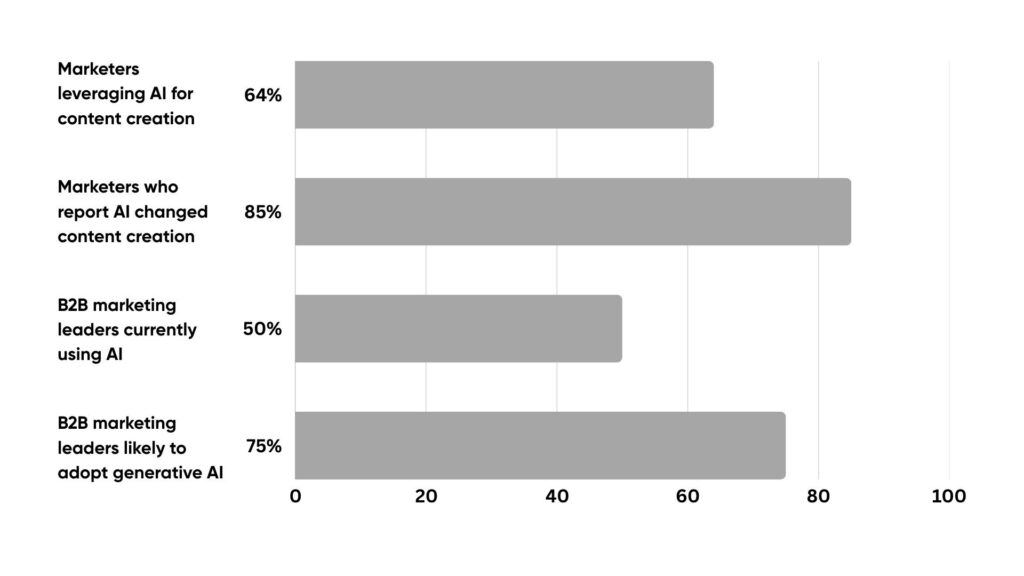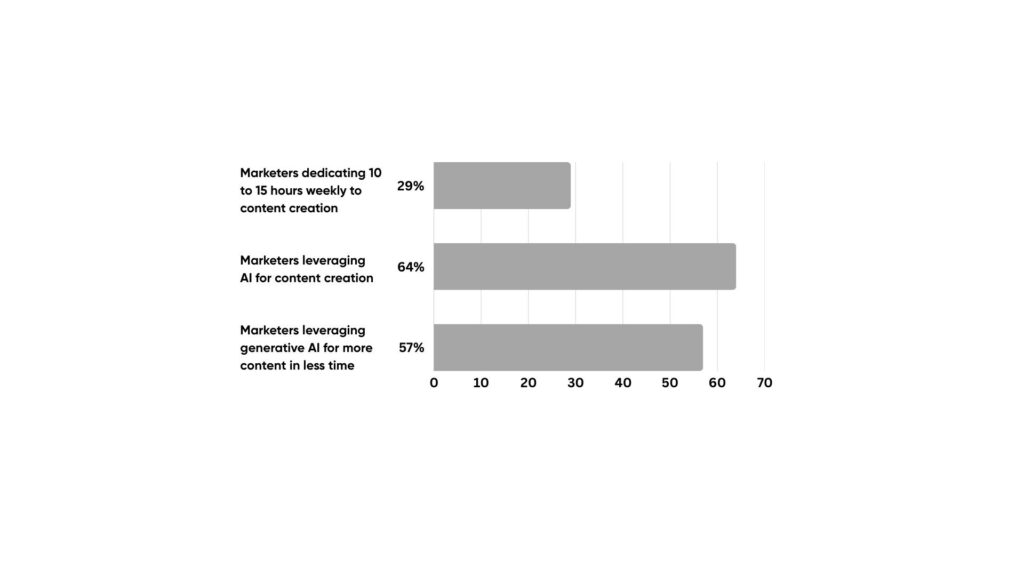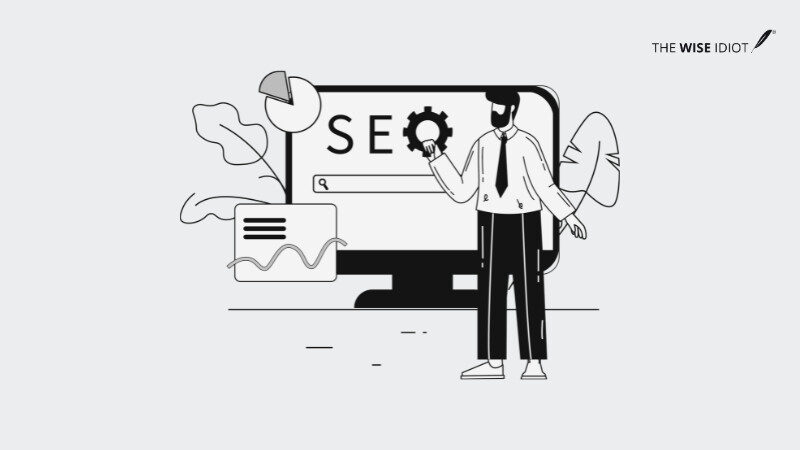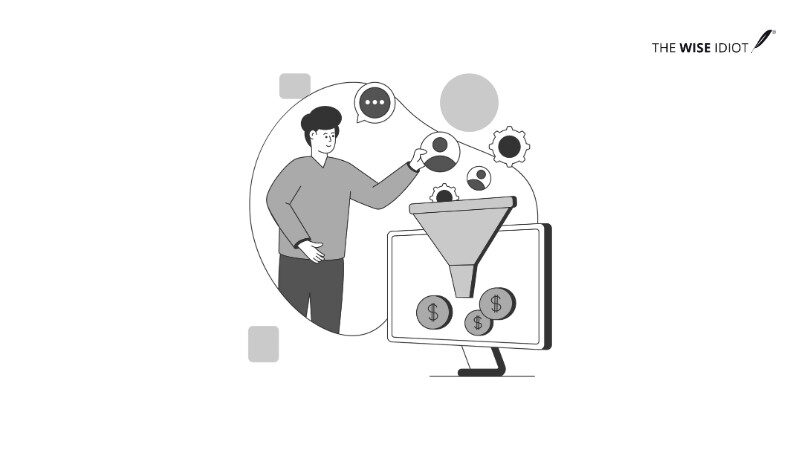B2B marketing moves at warp speed. Blink once and you might miss the next big shift. One moment you’re celebrating a campaign win, the next you’re scrambling to keep up with a brand-new trend.
This is 2025, a year that’s rewriting the playbook on how businesses connect, communicate, and convert. From AI-powered insights to the resurgence of brand-driven storytelling, this year’s B2B marketing trends 2025 playbook demands fresh thinking and a dash of daring.
So, pull up a chair, grab your coffee mug, and let’s stroll through the current B2B marketing landscape together.
1. AI and Automation: Your New Best Friends
You would’ve heard it a 1000 times already–AI isn’t the future anymore. But in 2025, AI is leveling up.
It’s like a super-smart buddy who digs through your data and hands you answers on a silver platter. Want to know how your webinars did last quarter? Just ask, “Hey, how’d we do?” and bam—charts and insights appear. This means marketers can ask questions about complex data in plain language and get instant answers, just like having a chat.
Similarly, content creation is going multimodal. Meaning, you can convert a blog post into a podcast script, a video storyboard, or even an infographic, all at the click of a button.
Agentic AI is on the rise too, stepping in to run routine campaigns and optimize paid ads autonomously. Your role is to focus on big-picture strategy.
Of course, measuring ROI on these new tools remains a challenge for now. But get it right, and you’ll leave your competition in the dust.

| Metric | Percentage |
| Marketers leveraging AI for content creation | 64% |
| Marketers who report AI changed content creation | 85% |
| B2B marketing leaders currently using AI | 50% |
| B2B marketing leaders likely to adopt generative AI | 75% |
2. Video and Visual Storytelling: Show, Don’t Just Tell
If a picture is worth a thousand words, a video is worth a million. In 2025, B2B buyers crave immersive, bite-sized experiences that cut through the noise. Be it a product demo, a virtual factory tour, or a customer success story, video delivers engagement you won’t get from plain text.
And when you weave in infographics, dynamic slide decks, and short-form clips for platforms like TikTok or Instagram Reels, you’re speaking the language of Gen Z and younger Millennials. These buyers expect brands to entertain as much as they inform.
But beware: low-quality visuals can do more harm than good. Investing in clear, crisp production and storytelling that resonates is non-negotiable. Remember, people buy from people, so let your brand’s personality shine. Behind-the-scenes peeks, candid interviews, and user-generated content can humanize even the most technical offerings.
SalesHandy nails it: “As of 2024, a mind-boggling 96% of B2B organizations are using video content to market their products and services!”
3. Personalization at Scale: One Size Fits No One
Generic emails are so last decade. Gone are the days of “Dear Valued Customer.” Today’s B2B buyers expect messages that feel tailor-made, down to the moment they engage with your website or open your email.
With advanced analytics, AI-driven segmentation, and marketing automation, you can serve up individualized content journeys. It’s like a campaign that adjusts messaging based on industry, company size, and past interactions, all manual efforts.
All you need is a mindset shift: treat each client as a unique human (yes, they are), not a line on a spreadsheet. Use data to anticipate their questions, personalize recommendations, and deliver the right content at the right time.
The payoff is huge: stronger relationships, better conversion rates, and more predictable revenue growth.
McKinsey says, “71% of B2B customers expect personalized sales interactions, and they get frustrated when interactions are not customized to their needs!”
4. Brand-Led Marketing and Values: Stand for Something
For a while, B2B marketing was all about features, features, features. But in 2025, brand equity is making a blockbuster comeback.
Buyers want more than a logo; they want to understand who you are, what you stand for, and why you exist. That means investing in brand storytelling: consistent visuals, a cohesive content voice, and campaigns that reflect your core values.
And to be honest, today’s decision-makers, especially younger ones, don’t settle for bland statements. They demand authenticity.
If you claim to champion sustainability or diversity, your content better walk the talk. When values align, when your mission resonates with theirs, you build loyalty that outlasts any discount or demo.
5. Chasing the Next Generation: Gen Z and Beyond
Gen X and Boomers might control the budgets today, but the next wave of B2B buyers is already here. Gen Z and younger Millennials have grown up with Instagram algorithms curating their every scroll. They expect the same fluid, interactive experiences in their professional lives.
That means leaning into short-form video, interactive webinars, and social-first campaigns that feel less like advertising and more like conversation.
But don’t abandon your existing audiences entirely, there’s still opportunity in under-served segments. Smarter segmentation can help you nurture Boomers and Gen X alongside your newer cohorts. Mix it up, and you’ll keep everyone happy.
6. The Non-Linear Buyer Journey and “Handraisers”
Forget the old linear funnel. Today’s buyers loop back, side-step, check blogs, watch videos and sometimes abandon ship entirely, only to return later, more informed.
Marketing’s job is to meet them on their own terms, across ten or more channels. That’s what omnichannel engagement is: unified messaging across email, social, chatbots, and events. Provide educational assets at every stage.
And when a prospect signals readiness, ‘raises their hand’, you need a clear, frictionless path to sales (one-click calls, not endless forms).
7. B2B Influencer Marketing: The Underdog Weapon
When you think “influencer,” you probably picture glossy lifestyle content. But in B2B, niche thought leaders, those micro-influencers with 5,000 to 50,000 deeply engaged followers, are gold mines.
They’re trusted voices in specialized communities, willing to co-create webinars, write joint whitepapers, or share product demos with authenticity you simply can’t buy through ads.
Sure, only 24% of B2B marketers have formal influencer programs right now, but that’s ripe for disruption. Start small, measure impact, and watch your credibility. The reach will soar.
8. Data-Driven Decisions and Privacy: The Balancing Act
You can’t market effectively without data, but mishandled data is a PR nightmare.
In 2025, top marketers are mastering both sides: harnessing analytics platforms to spot emerging trends, fine-tune segmentation, and optimize spend, while also enforcing airtight privacy and security protocols.
GDPR, CCPA, and their global cousins demand transparent policies, encrypted storage, and regular audits.
Communicate your safeguards clearly because clients want reassurance that their information is treated with the same care you’d expect for your own. Nail this balance, and you’ve earned trust that money can’t buy.
9. Voice Search and Conversational SEO
“Hey Siri, where can I find the best B2B CRM demo?”
Voice assistants are everywhere now. Optimizing for conversational queries means anticipating full, natural-language questions and answering them directly in your content. So, write answers that sound natural.
That could be a detailed FAQ section, schema-marked snippets, or localized landing pages for voice-driven, on-the-go searches.
If you haven’t claimed and updated your business listings, optimized page load speeds, and structured your content for LLM-friendly consumption, 2025 is the wake-up call. If you’re not ready for voice, you’re missing out big time.
10. Upskilling and Content Creation: Invest in Your People
All these trends—video production, AI-driven analytics, voice optimization—require fresh skills. The smartest teams are building internal academies, hosting regular workshops, and hiring specialist creators.
Freelancers and contract experts can fill gaps, but long-term mastery comes from empowering your full-time crew with the latest tools and methodologies.
Continuous learning is the lifeline that keeps your marketing engine humming. WordStream, citing SurveyMonkey, warns, “More than half of marketers say AI is already important in their role, but 70% said their employers don’t provide generative AI training.” Here’s what’s at stake:

| Statistic | Percentage |
| Marketers dedicating 10 to 15 hours weekly to content creation | 29% |
| Marketers leveraging AI for content creation | 64% |
| Marketers leveraging generative AI for more content in less time | 57% |
Wrapping Up
So here’s the bottom line: the B2B marketing trends in 2025 isn’t a static list of tactics, it’s a living ecosystem. It’s about blending cutting-edge tech with genuine human connection, creating stories that resonate, and building systems that adapt as quickly as your audience’s needs shift.
After all, the skills we need today (interactive video editing, conversational SEO, AI orchestration), will be table stakes tomorrow.
Embrace this journey, keep your curiosity fired up, and remember: the future isn’t just happening to us, we’re the ones writing it.
FAQs
- What are the top B2B marketing trends in 2025?
The top B2B marketing trends 2025 include AI-driven automation, personalized content at scale, video and visual storytelling, brand-led marketing, and influencer collaborations. These trends are reshaping how businesses engage and convert audiences. - How is AI impacting B2B marketing in 2025?
AI is transforming B2B marketing by automating data analysis, personalizing content, generating multimodal assets, and running campaigns autonomously. It enables real-time insights and faster content creation and makes marketing efforts more efficient and targeted. - Why is brand storytelling important in B2B marketing trends for 2025?
In 2025, brand storytelling helps businesses stand out by showcasing values, mission, and personality. B2B buyers are looking for authentic connections, not just features. A strong brand story builds trust, loyalty, and long-term relationships.









